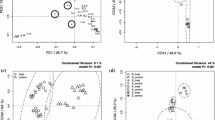Abstract
The degradation dynamics of polyhydroxyalkanoates of different composition has been studied in an eutrophic storage reservoir for two seasons. It has been shown that the biodegradation of polymers under natural conditions depends not only on their structure and physicochemical properties but also, to a great extent, on a complex of weather-climatic conditions affecting the state of the reservoir ecosystem. The molecular genetic analysis of 16S rRNA has revealed bacterial species (clones) probably involved in the degradation of polyhydroxyalkanoates in a model storage reservoir.
Similar content being viewed by others
References
Shimao, M., Biodegradation of Plastics, Curr. Opin. Biotechnol, 2001, vol. 12, pp. 242–247.
Müller, R.-J., Kleeberg, I., and Deckwer, W.-D., Biodegradation of Polyesters Containing Aromatic Constituents, J. Biotechnol., 2001, vol. 86, pp. 87–95.
Sudesh, K., Abe, H., and Doi, Y., Synthesis, Structure and Properties of Polyhydroxyalkanoates: Biological Polyesters, Prog. Polym. Sci., 2000, vol. 25, pp. 1503–1555.
Jendrossek, D. and Handrick, R., Microbial Degradation of Polyhydroxy alkanoates, Annu. Rev. Microbiol., 2002, vol. 56, pp. 403–432.
Leathers, T.D., Govind, S., and Greene, R.V., Biodegradation of Poly(3-Hydroxybutyrate-co-3-Hydroxyvalerate) by a Tropical Marine Bacterium, Pseudoalteromonas Sp. NRRL B-30083, J. Polymers and Environ, 2000, vol. 8, pp. 119–124.
Khan, S.T. and Hiraishi, A., Isolation and Characterization of a New Poly(3-Hydroxybutyrate)-Degrading, Denitrifying Bacterium from Activated Sludge, FEMS Microbiol. Lett., 2001, vol. 205, pp. 253–257.
Lerman, L.S., Fischer, S.G., Hurley, I., Silverstein, K., and Lumelsky, N., Sequence-Determined DNA Separations, Annu. Rev. Biophys. Bioeng., 1984, vol. 13, pp. 399–423.
Poglazova, M.N. and Mitskevich, I.N., Application of Fluorescamine for Determination of Microbial Numbers in Seawater by the Epifluorescence Method, Mikrobiologiya, 1984, vol. 53, no. 5, pp. 850–857.
Vogelstein, B. and Gillespie, D., Preparative and Analytical Purification of DNA from Agarose, Proc. Natl. Acad. Sci. USA, 1979, vol. 76, pp. 615–619.
Schauer, M., Massana, R., and Pedros-Alio, C., Spatial Differences in Bacterioplankton Composition Along the Catalan Coast (NW Mediterranean) Assessed by Molecular Fingerprinting, FEMS Microbiol. Ecol., 2000, vol. 33, pp. 51–59.
Volova, T.G., Belyaeva, O.G., Plotnikov, V.F., and Puzyr’, A.P., Studies of Biodegradation of Microbial Polyhydroxyalkanoates, Prikl. Biokhim. Mikrobiol., 1998, vol. 34, no. 5, pp. 539–543 [Appl. Biochem. Microbiol. (Engl. Transl.), vol. 34, no. 5, pp. 488–492].
Gladyshev, M.I., Gribovskaya, I.V., and Adamovich, V.V., Disappearance of Phenol in Water Samples Taken from the Yenisei River and the Krasnoyarsk Reservoir, Water Res., 1993, vol. 27, no. 6, pp. 1063–1070.
Gladyshev, M.I., Sushchik, N.N., Kalachova, G.S., and Shchur, L.A., The Effect of Algal Blooms on the Disappearance of Phenol in a Small Forest Pond, Water Res., 1998, vol. 32, no. 9, pp. 2769–2775.
Volova, T.G., Sevast’yanov, V.I., and Shishatskaya, E.I., Polioksialkanoaty — biorazrushaemye polimery dlya meditsiny (Polyhydroxyalkanoates, Biodegradable Polymers for Medical Purposes), Novosibirsk: Izdatel’stvo SO RAN, 2003.
Suyama, T., Tokiwa, Y., Ouichanpagdee, P., Kanagawa, T., and Kamagata, Y., Phylogenetic Affiliation of Soil Bacteria That Degrade Aliphatic Polyesters Available Commercially as Biodegradable Plastics, Appl. Environ. Microbiol., 1998, vol. 64, pp. 5008–5011.
Ruiz, J.A., López, N.I., Femández, R.O., and Méndez, B.S., Polyhydroxyalkanoate Degradation Is Associated with Nucleotide Accumulation and Enhances Stress Resistance and Survival of Pseudomonas oleovorans in Natural Water Microcosms, Appl. Environ. Microbiol., 2001, vol. 67, pp. 225–230.
Khan, S.T., Horiba, Y., Yamamoto, M., and Hiraishi, A., Members of the Family Comamonadaceae as Primary Poly(3-Hydroxybutyrate-co-3-Hydroxyvalerate)-Degrading Denitrifiers in Activated Sludge As Revealed by a Polyphasic Approach, Appl. Environ. Microbiol., 2002, vol. 68, pp. 3206–3214.
Author information
Authors and Affiliations
Corresponding author
Additional information
Original Russian Text © T.G. Volova, M.I. Gladyshev, M.Yu. Trusova, N.O. Zhila, 2006, published in Mikrobiologiya, 2006, Vol. 75, No. 5, pp. 682–688.
Rights and permissions
About this article
Cite this article
Volova, T.G., Gladyshev, M.I., Trusova, M.Y. et al. Degradation of polyhydroxyalkanoates and the composition of microbial destructors under natural conditions. Microbiology 75, 593–598 (2006). https://doi.org/10.1134/S0026261706050092
Received:
Accepted:
Issue Date:
DOI: https://doi.org/10.1134/S0026261706050092




